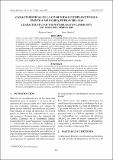Por favor, use este identificador para citar o enlazar este ítem:
https://hdl.handle.net/20.500.12958/7768| Título : | Características de la comunidad fitoplanctónica frente a Máncora, primavera 2018 |
| Otros títulos : | Characteristics of the phytoplankton community off Máncora, spring 2018 |
| Autor : | Franco, Augusto Sánchez, Sonia |
| Palabras clave : | Fitoplancton;Volúmenes de plancton;Máncora |
| Fecha de publicación : | jun-2023 |
| Editorial : | Instituto del Mar del Perú |
| Citación : | Franco, A. y Sánchez, S. (2023). Características de la comunidad fitoplanctónica frente a Máncora, primavera 2018. Inf Inst Mar Perú, 50(2), 232-239. |
| Citación : | Informe IMARPE 50(2), 2023; |
| Resumen : | Durante diciembre 2018, en el área de Máncora, se recolectaron muestras de fitoplancton con la finalidad de contar con una línea de base. Se analizaron volúmenes de plancton y muestras semicuantitativas y cuantitativas para conocer abundancia, composición y distribución del fitoplancton. Los volúmenes de plancton fueron relativamente bajos variando entre 0,03 y 0,38 mL.m-3, con predominancia de zooplancton en 94 % de estaciones. El análisis semicuantitativo indicó que los
dinoflagelados (50,9 %) y las diatomeas (47,2 %) tuvieron la mayor contribución con el fitoplancton a
nivel superficial. El análisis cuantitativo (10 m de profundidad) indicó que el nanofitoplancton presentó
mayor abundancia predominando hacia la zona norte de Punta Restinta. La mayor diversidad y riqueza
especiológica se ubicó entre las zonas central y sur del área de estudio (entre Punta Restinta y Talara),
donde se observa mayor contribución del grupo de diatomeas. ABSTRACT: In December 2018, plankton samples were collected in the Máncora area to establish a baseline for future studies. Both plankton volumes and semi-quantitative and quantitative samples were analyzed to determine the abundance, composition, and distribution of phytoplankton. Plankton volumes were relatively low, ranging from 0.03 to 0.38 mL.m-3, with zooplankton dominating 94 % of stations. The semi-quantitative analysis indicated that dinoflagellates (50.9 %) and diatoms (47.2 %) made the greatest contribution to surface-level phytoplankton. The quantitative analysis at a depth of 10 meters showed that nanophytoplankton was more abundant, mainly towards the northern area of Punta Restinta. The greatest diversity and species richness were found between the central and southern zones of the study area (between Punta Restinta and Talara), where diatoms were the most prevalent group. |
| URI : | https://hdl.handle.net/20.500.12958/7768 |
| ISSN : | 0378-7702 |
| Aparece en las colecciones: | Informe vol. 50(2) 2023 |
Ficheros en este ítem:
| Fichero | Descripción | Tamaño | Formato | |
|---|---|---|---|---|
| Informe 50(2) Articulo 9.pdf | 600,27 kB | Adobe PDF |  Visualizar/Abrir |
Este ítem está sujeto a una licencia Creative Commons Licencia Creative Commons

